The Upfront Cost Hurdle of EDC
Although costs can force some sponsors to think twice, data show downstream savings add up.
Electronic data capture (EDC) is a well-established building block for bringing far-reaching efficiencies to the clinical trials process. It has gained a firm foothold in the clinical trials market, with estimates for new trials starting with EDC in the 50% range.1 EDC's growing presence has come a long way from its early roots of double entry systems on stand-alone desktop computers in the 1990s, emerging as a Web-based user-friendly tool for improving data quality, lowering costs, cutting clinical development timelines, and ultimately accelerating time to market.

Despite EDC's established history and a perception that "everyone is using EDC," many biopharmaceutical and medical devices sponsors continue to conduct paper-based studies. Mostly they cite the upfront cost of transitioning to EDC as a barrier. As part of this perception, they may believe that EDC solutions are generally too big for smaller companies, or they may be unsure about the vendor's ability to deliver high-quality technology, training, and customer service, as promised. There could also be some level of discomfort as to how EDC will be implemented and how processes, standard operating procedures, and jobs will change to accommodate the new technology.
Yet, research supports that EDC is here to stay. As evidence, a recent report by William Blair & Company2 states that the benefits of EDC are recognized by major industry players such as GlaxoSmithKline, Merck, and Novartis, who are moving toward using EDC in 100% of their clinical trials. The Blair report states that the EDC market is projected to grow 15% annually through 2012.
The case for EDC
At a time when sponsors are challenged with filling pipelines, conducting complex global clinical trials that generate a rising volume of data points,3 and complying with postmarketing requirements for additional safety and efficacy data, they are seeking to streamline as many processes as possible along the product lifecycle continuum. Clinical development is targeted as a key area in need of greater efficiencies and a lower cost structure. Research suggests that while costs associated with drug development are increasing at an annual rate of 11.8%,4 sales are growing at a slower pace, in the range of 4.5% to 5.5% globally, and 2% to 5% in the United States.5 Moving away from paper-based processes that are labor-intensive, repetitive, and error-prone, and edging toward electronic solutions, such as EDC, is essential for achieving the efficiencies needed to speed development and better align development costs with sales revenues.
Fortunately, there is evidence that this is already happening. A contract research organization (CRO) survey performed in late 2008 reveals that 45% of respondents (n = 18) currently conduct more than half of their studies using EDC. The survey also revealed that within three years, 85% of respondents predict using EDC in 50% of their trials.2 Another study performed by a provider of clinical trial services showed similar acceptance.6 It was performed in late 2006 and included 190 respondents, mostly biopharmaceutical sponsors. Fully 86% reported using EDC at least once. Additionally, 50% stated that EDC was more attractive as an outsourced service than as a technology-only offering to be managed internally.
With these data as background, it is apparent that EDC has made substantial inroads. But still, many cling to paper. For companies considering making the transition, they may want to evaluate not only the benefits of EDC but also what it takes for successful implementation. Deciding factors include cost of EDC compared to paper, ability to make necessary internal process changes, buy-in from key managers, and identifying the right EDC provider with the right solution.
Cost of EDC vs. paper
Making the decision to conduct trials with EDC requires a careful analysis of its total costs versus those of paper-based processes. When making a true cost comparison, decision makers need to consider more than the upfront cost of purchasing an EDC system. Focusing only on the upfront cost completely overlooks the significant downstream cost savings realized by being able to reduce the number of queries, have faster query resolution, faster visibility of the data by sponsors and CROs, and fewer monitoring visits. There are also significant savings accrued by completing the last patient/last visit weeks or months sooner than its paper-equivalent, and by locking the database faster. And these benefits tend to be cumulative as efficiencies linked to new technologies generally increase over time as end users gain familiarity with them through repeated use.
Research by Banik found measurable improvements in clinical trial efficiency when using EDC as compared to paper.7 In an analysis of a five country, 19-site asthma study with 226 subjects, the EDC arm showed a 30% decline in study duration, a 43% decline in the time to database lock, and an 86% drop in the number of queries. These findings support the value of including downstream savings as well as direct costs and upfront expenses when evaluating costs.
When making a cost comparison, direct costs should include the cost of double data entry per page, monitoring visits, the average cost of query resolution, downstream savings and other factors (see sidebar Cost Considerations: EDC vs. Paper).
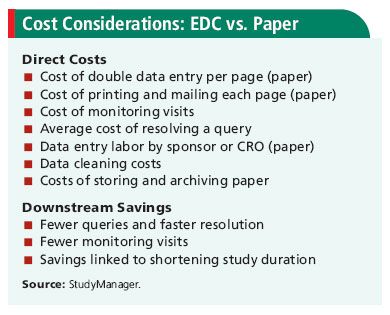
Using these factors, two cost comparisons were performed that document the overall savings that are possible with EDC. First is a study conducted by an industry consultant, using a cost model.8 The study is based on 11 actual Requests for Proposals (RFPs) developed by multiple EDC providers for Phase IIb and III trials. Clients, as well as the providers, are large, medium and small.
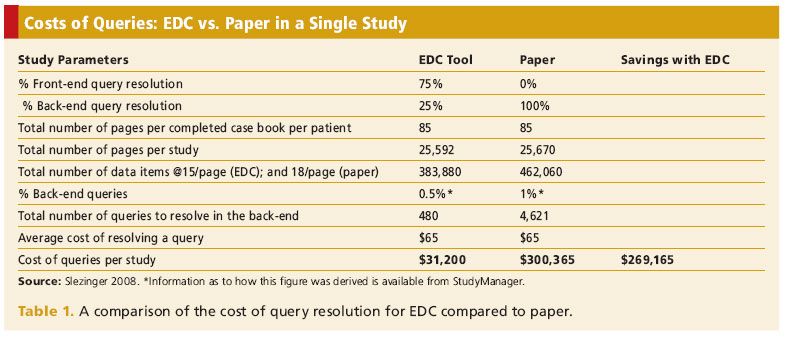
The cost model includes the following assumptions:
- 30 sites per trial
- 350 subjects per trial
- 25 unique case report forms per study
- Study duration of 14 months
- Costs of $1.50 to $1.75/page for double data entry for paper-based systems, and $1.50 to $1.75/page for printing and mailing costs of paper documents

Table 1 compares the cost of query resolution throughout the study, Table 2 depicts savings in monitoring costs, and Table 3 shows net savings after factoring in the cost of an EDC system. Based on these assumptions, there are significant savings linked to reductions in the cost of query resolution, monitoring visits, and paper handling. As shown in Table 3, considering the cost of an EDC system, the overall benefit of EDC exceeds $368,000 for a single study.

The second comparison, a study conducted by Forrester Research, projected similar savings when comparing use of EDC against paper in a Phase II study: $347,600.9 The findings were based on a 20-site study, 200 subjects (10 patients/site), and a 12-month study duration plus time for data cleaning. Furthermore, in a Phase III scenario with 200 sites, 2000 subjects (10 patients/site), and a 24-month duration plus time for data cleaning, Forrester identified downstream savings of $6.25 million in favor of EDC (see Table 4).

EDC survey
The cost models illustrate that EDC brings measurable cost efficiencies to sponsors, CROs, and end users, but with an estimated 50% acceptance rate in the industry, there is room for greater utilization. At this point in the adoption cycle, it is useful to measure views of EDC users, such as their opinion of their EDC solution, how they chose an EDC provider, and the role of cost in their decision making. This information may prove meaningful for companies intending to make the switch.
To start the process, a recent survey was conducted by StudyManager, maker of a suite of clinical trial management system (CTMS) and EDC solutions of the same name. Results of the survey are meant to generate supportive data to identify desired EDC options, key performance indicators, and purchase factors.
The survey contained 22 questions and was conducted online over a six-week period, starting in May 2009. It was sent to a targeted audience, including members of the Society for Clinical Data Management (SCDM) and the Association of Clinical Research Professionals (ACRP). It was also placed on multiple social networking sites that have biopharmaceutical, medical device, and clinical trial groups, such as Twitter, Facebook, and LinkedIn.
There were 62 respondents. Of those, 95% reported having some experience with EDC, and 89% reported having at least six months of experience. Approximately 90% claimed that their organizations have used EDC.
Questions were divided in various categories. First, it asked respondents about the length of time it should take to become competent in using the system; and for those whose companies have already chosen a system, whether it contains all of the necessary features and integrates well with external sources. Next were a series of questions about the selected EDC provider, looking at areas such as cost, service, and support; ease of implementation training; and user interface. It also asked whether the provider is CDISC Operational Data Model (ODM)-compliant and if the system provides a portal or document management system that can host documents or communicate with external sites. The final four questions were targeted at respondents with at least six months of EDC experience.
What did the survey show? Perhaps the most important finding is that only 47% of respondents ranked cost of the EDC system as highly important when choosing a vendor. Among factors deemed as highly important, cost ranked the lowest of the four choices offered. As shown in Table 5, the factor to which the most respondents gave a highly important rating was user interface, at 75%. This finding is significant because upfront cost is most often pegged as the key barrier to EDC acceptance. Yet because nearly all of the respondents have experience with EDC, it is possible to speculate that they have begun to recognize and appreciate that initial costs are offset by the downstream benefits of the tool. So, their focus has possibly shifted from cost to factors that impact daily use, such as the importance of a good and easy-to-use interface.
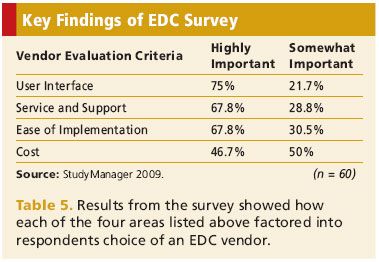
The importance of cost cannot be underestimated, however, because when the "somewhat important" rating is factored in, 97% of respondents pegged cost of the EDC system as an important consideration. Since respondents represented stakeholders of all sizes, this finding suggests that users in general are cost-sensitive. Extrapolating this finding, it is possible to speculate that the focus on cost provides a window into the thinking of smaller users who may believe EDC is out of reach of their more limited budgets. With today's flexible systems and modular structure, however, hesitant first-time users and smaller users can be eased into an EDC system priced to suit their needs. This applies to sponsors and to the growing number of CROs that are assuming responsibility for EDC as technology outsourcing increases.10
Some other key findings include:
- When asked how long it should take end users to become competent in using the system, 72% responded that it should take zero to two months. This highlights the plug-and-play mindset that prevails, and signals to providers that end-users expect EDC systems to be intuitive and easy-to-use, requiring minimal training. This expectation may overshadow the fact that successful EDC implementation is tied to process change that must be supported across the organization.
- More than half, 52%, report that their systems integrate only somewhat well with external data sources. This is a key indicator that users need to explore if they plan to automate functions beyond EDC, to include integration with clinical trial management systems, clinical data management systems, and other point solutions in keeping with the evolution toward eClinical trials.
- For users in the six-months or more category, nearly 60% claim that based upon their selection criteria and understanding of the software, their purchase assumptions were only somewhat correct. This finding suggests that potential users may want to spend more time defining their needs and possibly contacting references to better understand the right selection criteria.
A final look
Various factors at play are driving the transition from paper-based clinical trials to greater use of electronic data capture. First, there is the need for greater downstream efficiencies and lower costs in the clinical development process. There is increasing complexity, more globalization, and longer duration of clinical trials in response to requirements for more safety and efficacy data. Regulatory agencies around the world are starting to mandate use of electronic formats for submissions to bring efficiencies to the pre- and postmarketing review process, as mandated by legislation, such as the Food and Drug Administration Amendments Act (FDAAA) of 2007.11 And there is the growing adoption of standards from organizations such as Health Level Seven (HL7) and CDISC.
With all of these elements aligned, EDC is establishing itself as an essential tool for making change possible. Yet, for those sponsors who are still working with paper but want to join the transition, they often balk at the upfront cost of the tool. It is at this critical juncture that EDC providers can work with sponsors to identify the very real downstream savings that can offset the upfront expense. Cost models show significant savings for later phase studies, and these benefits are not just limited to the biggest players. Today's systems can be implemented in modular fashion, are priced to be affordable for users of all sizes, and training is provided. In addition, well-designed solutions can be integrated with functions such as CTMS and electronic patient reported outcomes (ePRO).
Joining the transition to EDC requires significant process change and company-wide commitment. Sponsors are aware of the needed change as evidenced in the survey. Some 95% of respondents expect EDC implementation to impact internal resource requirements either highly or somewhat. An experienced outsourced provider with a strong customer service focus can ease the transition.
Going forward, EDC is destined to play a larger role. It has been implemented mostly in studies in Phase IIb and later and its presence will expand, but it is also being considered for earlier studies and for the growing volume of studies linked to postmarketing commitments. With this move, it will be possible to generate electronic clinical trial data earlier on, starting from the beginning, yielding improved efficiencies, as well as time and cost savings, extending across the continuum.
Ann Neuer*is President of Medical deScriptions, Cincinnati, OH, email: [email protected]. Neil Warnock, MD, is Vice President of Medical Affairs at StudyManager, Seattle, WA. Edward Slezinger is an independent consultant located in Seattle, WA.
*To whom all correspondence should be addressed.
References
1. "Electronic Data Capture is on the Way Up," Health Industry Insights. Clinical Development Strategy and Technology Marketplace. Next Generation Pharmaceutical, October 2007, http://www.ngpharma.com/article/Electronic-data-capture-is-on-the-way-up.
2. J. Kreger, N. Nadler, R. Fatta, Pharmaceutical Outsourcing, Phase Forward, William Blair & Company, March 18, 2009.
3. P. McGee, "Managing the Clinical Data Flood," Drug Discovery & Development, February 7, 2006, http://www.dddmag.com/managing-the-clinical-data-flood.aspx.
4. M. Mathieu, ed., PAREXEL's Bio/Pharmaceutical R&D Statistical Sourcebook 2009/2010 (PAREXEL International Corporation, Waltham, MA, 2009) p 145.
5. "PRLog. NAPRx Forecasts 4.5-5.5 Percent Growth for Pharmaceutical Market in 2009, Exceeding $820 Billion," http://www.prlog.org/10164237-naprx-forecasts-45-55-percent-growth-for-pharmaceutical-market-in-2009-exceeding-820-billion.html
6. "Industry Survey Shows 50 Percent of Clinical Trials Professionals Find Electronic Data Capture More Attractive as Outsourced Service," BioClinica, March 12, 2007, http://www.bioclinica.com/industry-survey-shows-50-percent/.
7. N. Banik, "Evaluation of EDC versus Paper in a Multinational Asthma Trial," Presented at the DIA European Data Management Meeting, Berlin, October 1998.
8. E. Slezinger, Independent Consultant, Study Based on 11 RFPs developed by multiple EDC providers, 2008.
9. E. Brown, "Clinical Trials' EDC Endgame, Grading EDC Vendors and the Road to eClinical Suites," Forrester Research, September 29, 2004, p. 5.
10. TrialStat, "Best Practices for CROs Planning to Use EDC" April 2008, http://www.trialstat.com/CMS/%7B71692A13-69FE-4D10-A43D-477FCBAAF612%7D.pdf.
11. Food and Drug Administration Amendments Act (FDAAA), US Food and Drug Administration, http://www.fda.gov/RegulatoryInformation/Legislation/FederalFoodDrugandCosmeticActFDCAct/SignificantAmendmentstotheFDCAct/FoodandDrugAdministrationAmendmentsActof2007/default.htm.
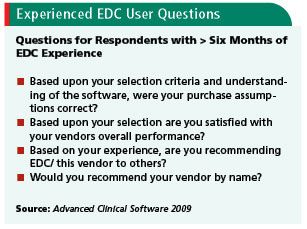
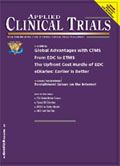
Improving Relationships and Diversifying the Site Selection Process
April 17th 2025In this episode of the Applied Clinical Trials Podcast, Liz Beatty, co-founder and chief strategy officer, Inato, discusses a number of topics around site engagement including community-based sites, the role of technology in improving site/sponsor relationships, how increased operational costs are impacting the industry, and more.
Behind the Buzz: Why Clinical Research Leaders Flock to SCOPE Summit
February 7th 2025In this episode, we meet with Micah Lieberman, Executive Conference Director for SCOPE Summit (Summit for Clinical Ops Executives) at Cambridge Innovation Institute. We will dive deep into the critical role of collaboration within the clinical research ecosystem. How do we bring together diverse stakeholders—sponsors, CROs, clinical trial tech innovators, suppliers, patients, sites, advocacy organizations, investors, and non-profits—to share best practices in trial design, program planning, innovation, and clinical operations? We’ll explore why it’s vital for thought leaders to step beyond their own organizations and learn from others, exchanging ideas that drive advancements in clinical research. Additionally, we’ll discuss the pivotal role of scientific conferences like SCOPE Summit in fostering these essential connections and collaborations, helping shape the future of clinical trials. Join us as we uncover how collective wisdom and cross-industry partnerships are transforming the landscape of clinical research.